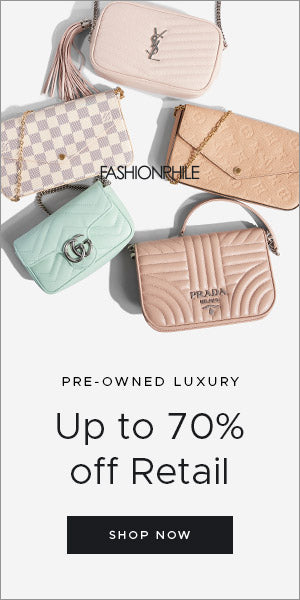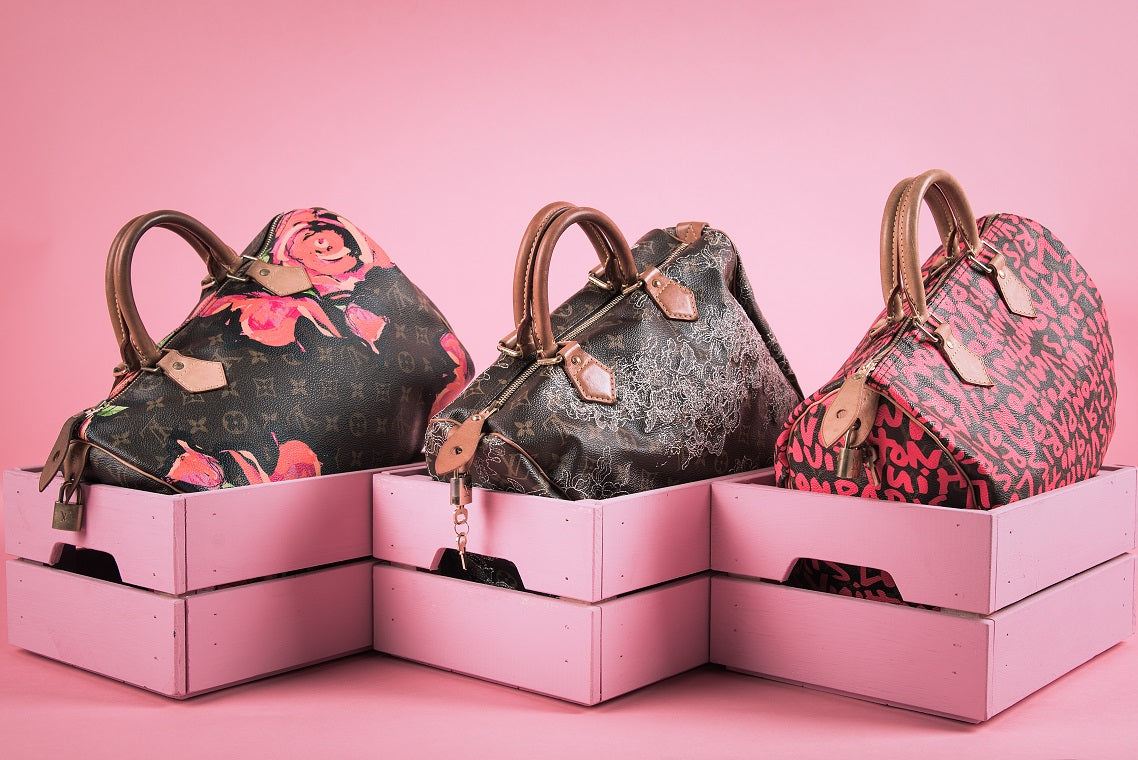
In the Roaring Twenties, when jazz and bootleg spirits flowed freely, men’s fashion and grooming reached new heights. A gentleman’s coiffure spoke volumes about his social status and individual style, becoming as iconic as the era itself.
Style was a statement.
The carefully sculpted contours of a slicked-back hair or the precision of a refined side part embodied the zeitgeist of the 1920s. These hairstyles became hallmarks of elegance during an age that rewrote the rules of fashion.
Slicked-Back Sophistication
In the hive of quintessential grooming, a discerning blend of elegance and control came forth through the slicked-back hairstyle. This look was impeccable, suggesting a man of meticulous character, one who approached life's arenas with poise and preparedness. Reflecting a seamless balance between polished restraint and alluring confidence, the slicked-back style became a silent yet profound emblem of one's dedication to personal standards and societal expectations.
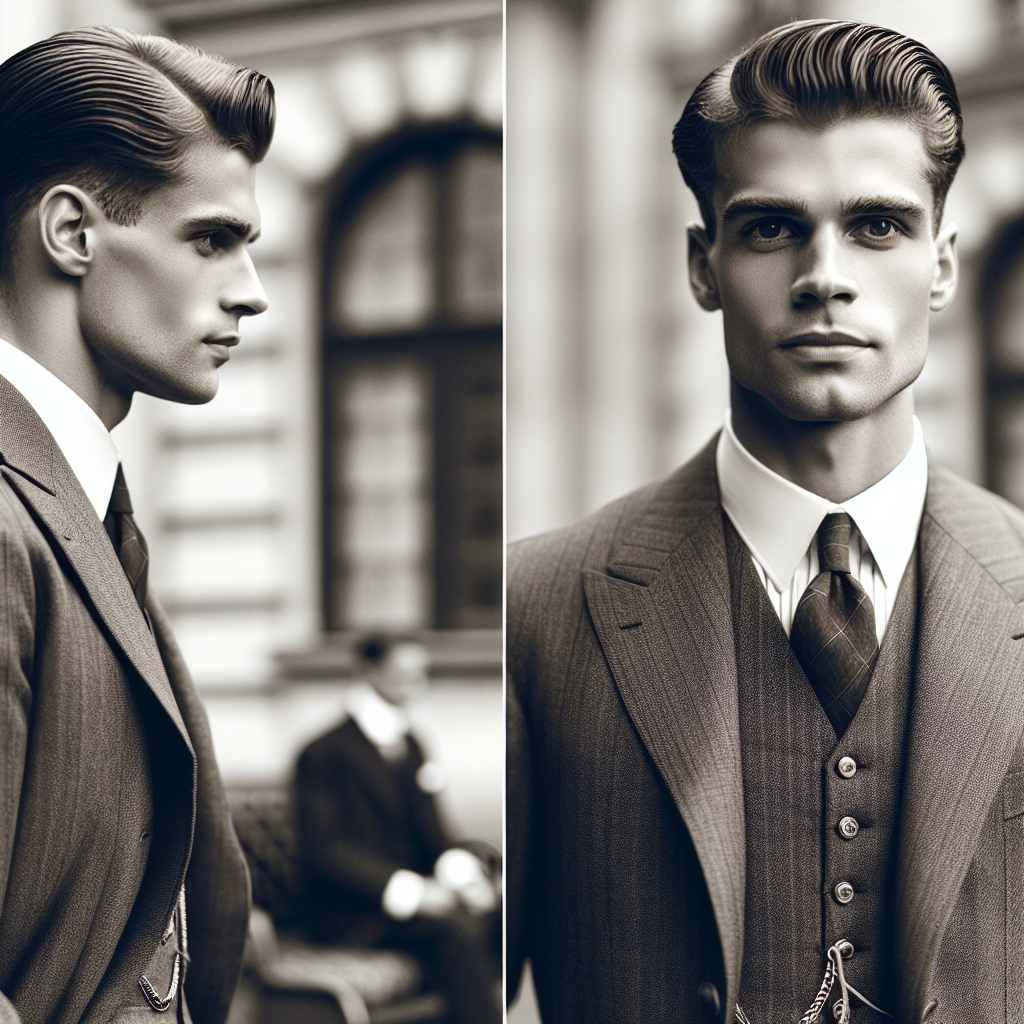
As an outward symbol of the composed dynamism typical of the 'Gatsby era', the slicked-back hair evoked a "boardroom aura". It was as if each strand was a stroke from an artist's brush, creating a canvas that spoke of prosperity, ambition, and unmatched sophistication. In this spirit, the sheen of the hair came to signify not just aesthetic appeal but an adherence to the highest levels of decorum and distinction, rendering the wearer as an archetype of the refined gentleman of the 1920s.
The Rise of Pomade
The 1920s saw an upsurge in the use of pomade—the quintessential hair styling product for men seeking lustrous sheens and malleable hold.
With pomade's advent, achieving the iconic gloss became attainable, heralding a new epoch in men's grooming rituals and aesthetics.
As men coveted polished appearances, pomade became indispensable for styles requiring precision and shine, its versatility allowing for both firm holds and slicked-back ease.
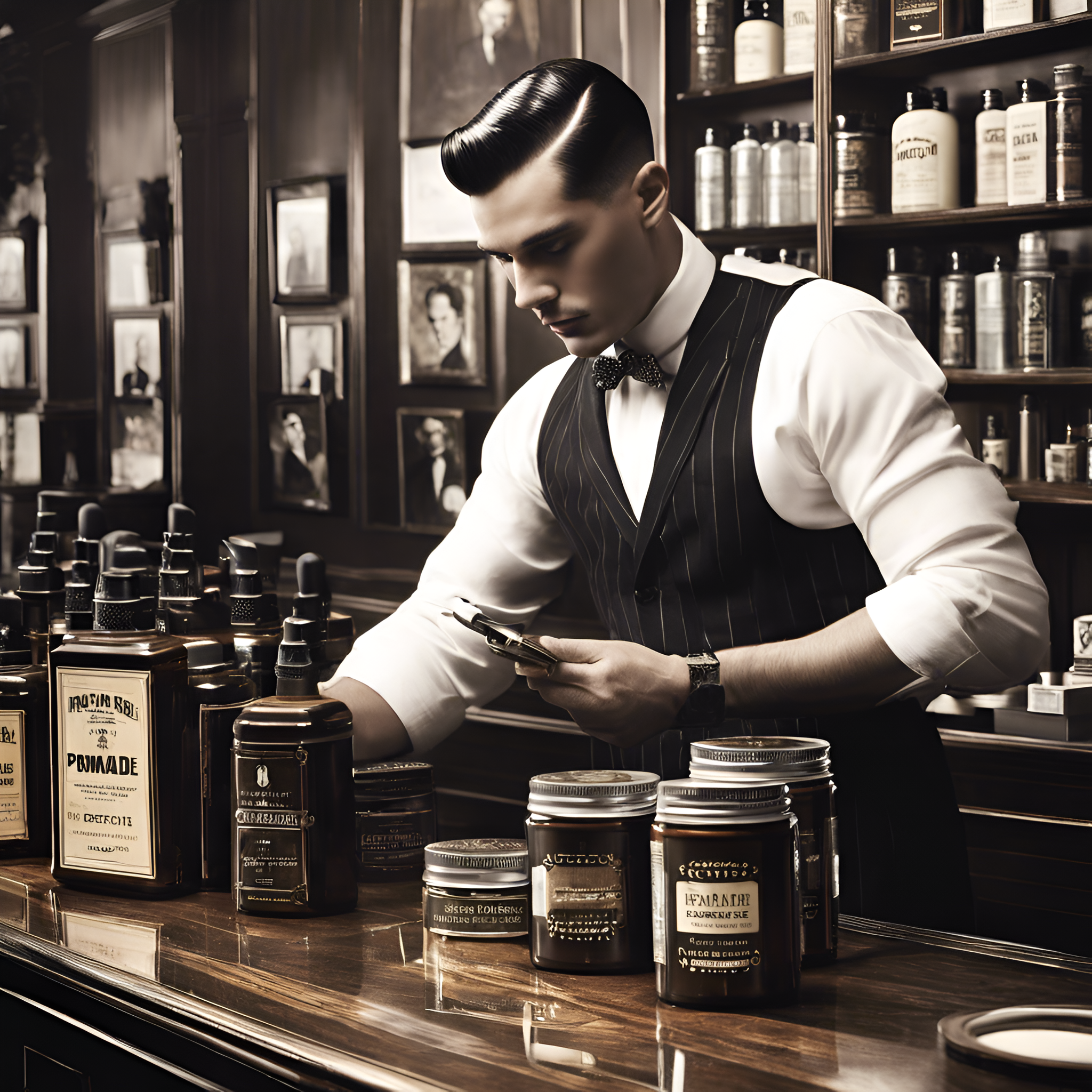
Pomade transcended mere functionality—emerging as a staple of male vanity and fashion, embodying the spirit of the roaring twenties and its relentless pursuit of elegance.
Iconic Side Parting
The ubiquitous side parting was more than a style; it epitomized 1920s masculinity and poise. Evenly sheared hairlines set apart the men who not only followed trends but set them.
![]()
This parting was synonymous with the put-together gentleman. Precision was paramount; anything less was uncouth.
Coupled with an artful application of pomade, it allowed hair to lay impeccably flat, crafting a silhouette of sleek sharpness. The part often acted as a visual extension of the well-tended eyebrow, continuing the line of meticulous grooming that framed the face.
In an era marked by its bold stylistic expressions, the side parting became a testament to personal pride and an exercise in daily elegance. This styling choice was emblematic of a man's stature within the societal landscape. Respected businesses and high-profile figures adopted this groomed appearance, testament to its influential reach and its status as a hallmark of the day's fashion consciousness.
Undercut: The Edgy Statement
The undercut emerged as a stark departure from the conservative, combed-over styles typical of the era's grooming standards. It presented a rebellious edge that contrasted sharply with the more traditional cuts, making a bold fashion statement during the 1920s.
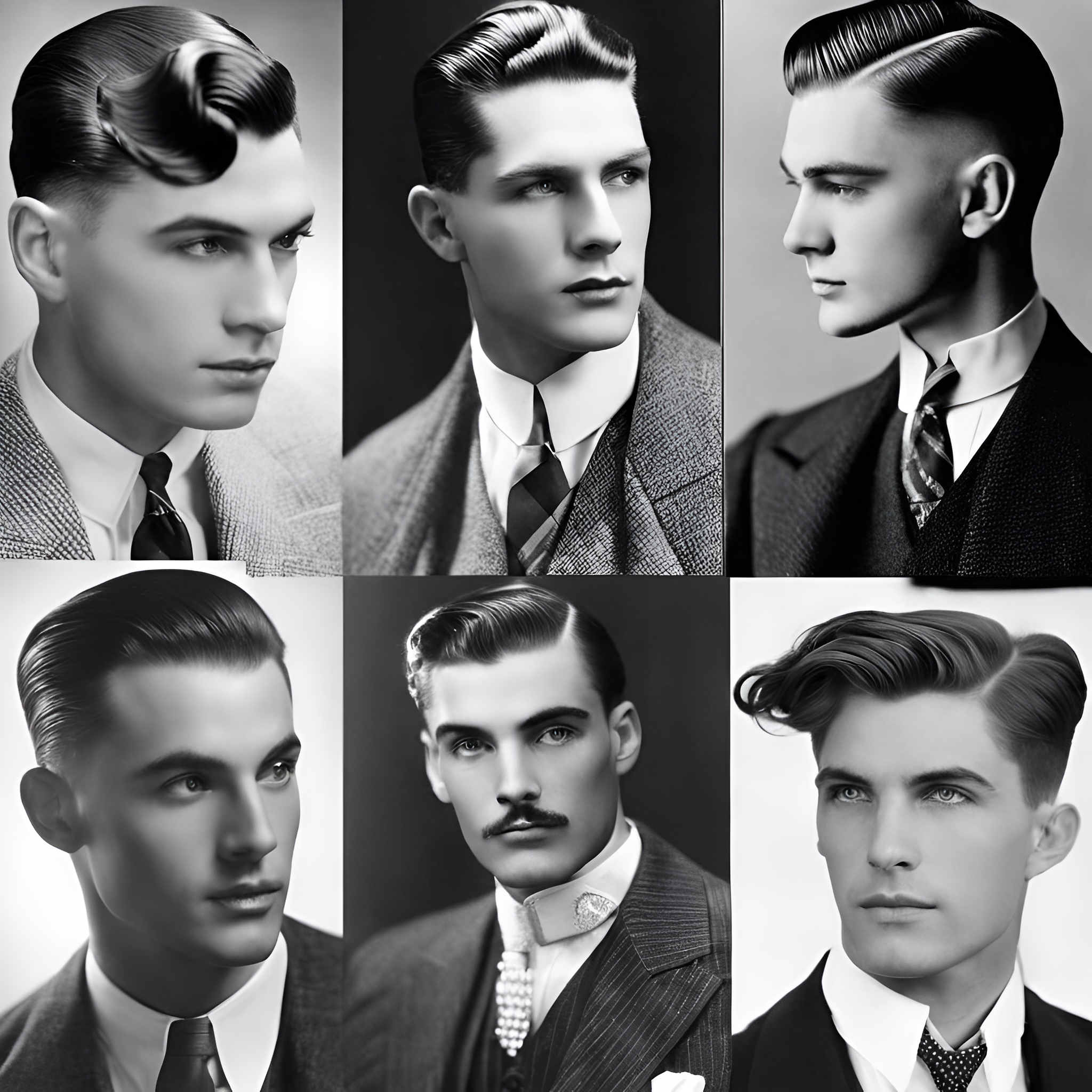
At its most fundamental, the undercut featured long top hair that was dramatically separated from the shaved or closely-cropped sides and back. The disconnection was intentional, highlighting a stark contrast that accentuated the wearer’s facial features and overall boldness of the style. It was a look that spoke of individuality and often hinted at a certain nonchalance towards societal conventions.

This cut’s daring “short sides, long top” approach would cyclically resurface in men's fashion, reflecting its time-tested appeal. As the 1920s progressed, the undercut became an undeniably iconic symbol of the decade's innovative approach to self-expression and style.
Peaky Blinders Influence
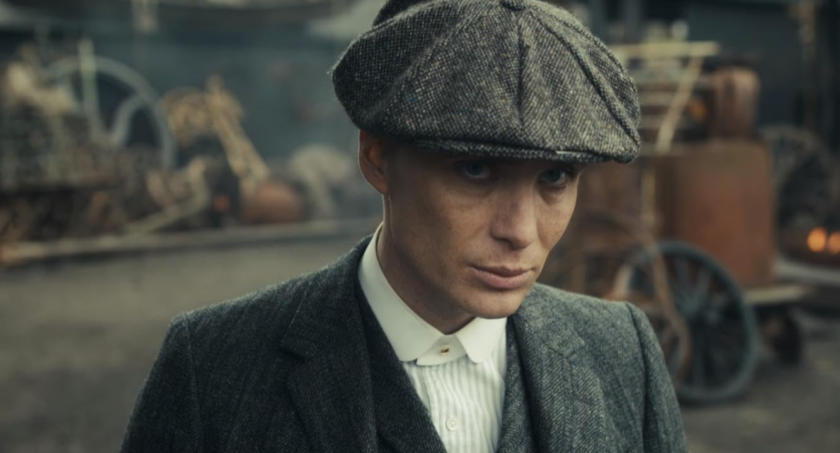
The resurgence of 1920s men's hairstyles owes much to the Peaky Blinders series, which has reintroduced and popularized these classic trends.
- Textured Crop: The successors of traditional 1920s styles, featuring a more modern, textured look.
- Side Parting: A nod to the era's sharp dressing and grooming standards, brought to life on screen.
- Buzz Cut: A low maintenance counterpart, revealing the raw, unadorned charm of the period.
- Forward Fringe: Characteristic of the thuggish yet stylish look epitomized by Peaky Blinders' characters.
- Classic Slick Back: Reinvented with an edgier vibe in the series, connecting past elegance with contemporary edge.
These styles are not just haircuts; they are statements of a historical narrative revived.
Understanding the magnetic appeal of these styles requires appreciating their cultural and cinematic relevance.
Backstreet Barbering Techniques
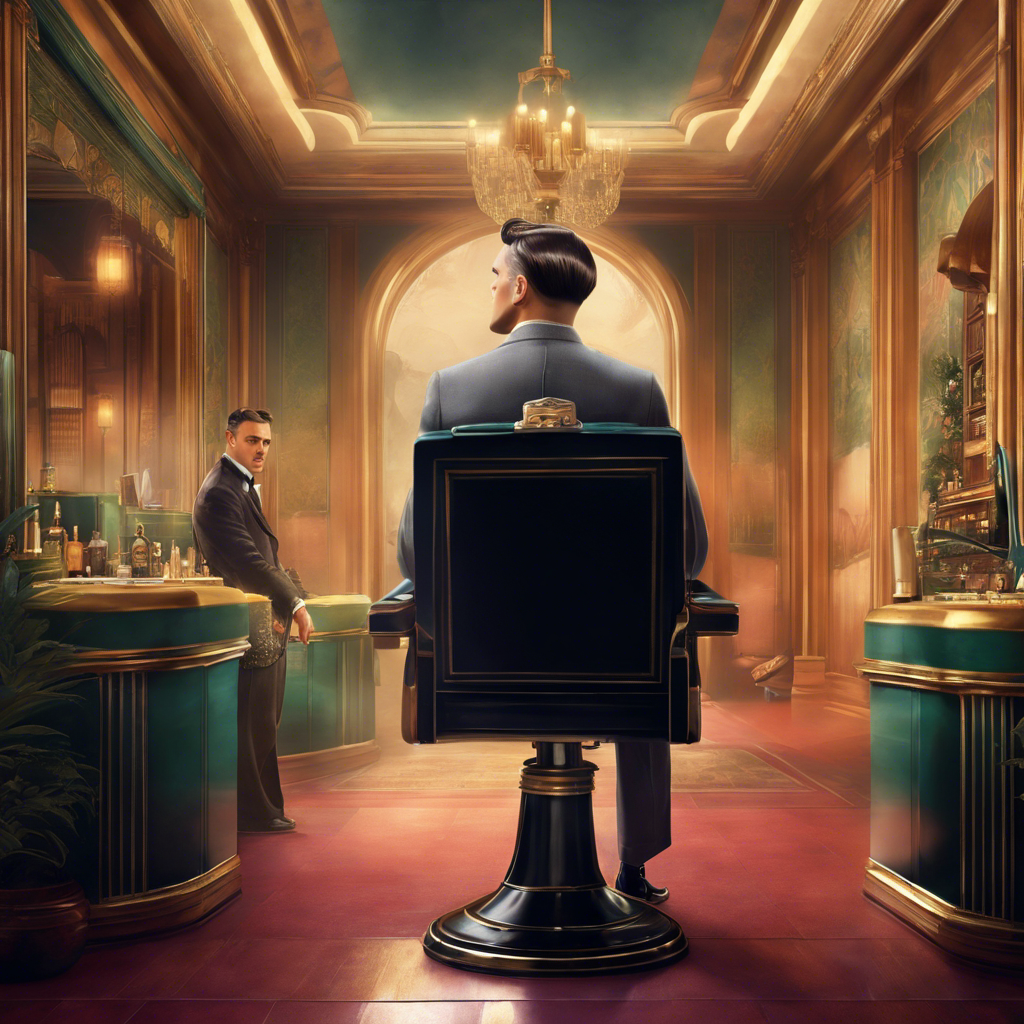
In the clandestine corners of 1920s urban landscapes, backstreet barbers honed unique skills in a time where hairstyling began to define personal identity.
- Freehand Clipper Work: Crafting close cuts without guard attachments for precise control.
- Razor Shaping: Using straight razors to sculpt sharp lines and clean edges.
- Thinning Shear Mastery: Employing specialized shears to achieve the era's characteristic texture.
- Tonic Brews: Mixing hair tonics with natural ingredients for hold and shine.
Barbers of the era would often blend instinct with skill, adapting techniques to suit individual customer hair types and head shapes.
Their hands were instruments of cultural craftsmanship, silent narrators of the subtle yet significant shifts in men's societal roles and expressions.
Waves and Curls: Embracing Texture
The 1920s exalted texture as a paramount feature in men's hairstyles, merging soft undulations with sharply tailored suits.
While hair straighteners were used sparingly, the predominant methods for achieving waves involved skillful finger-waving and the strategic application of brilliantine or pomade to enhance the natural movement of the hair.
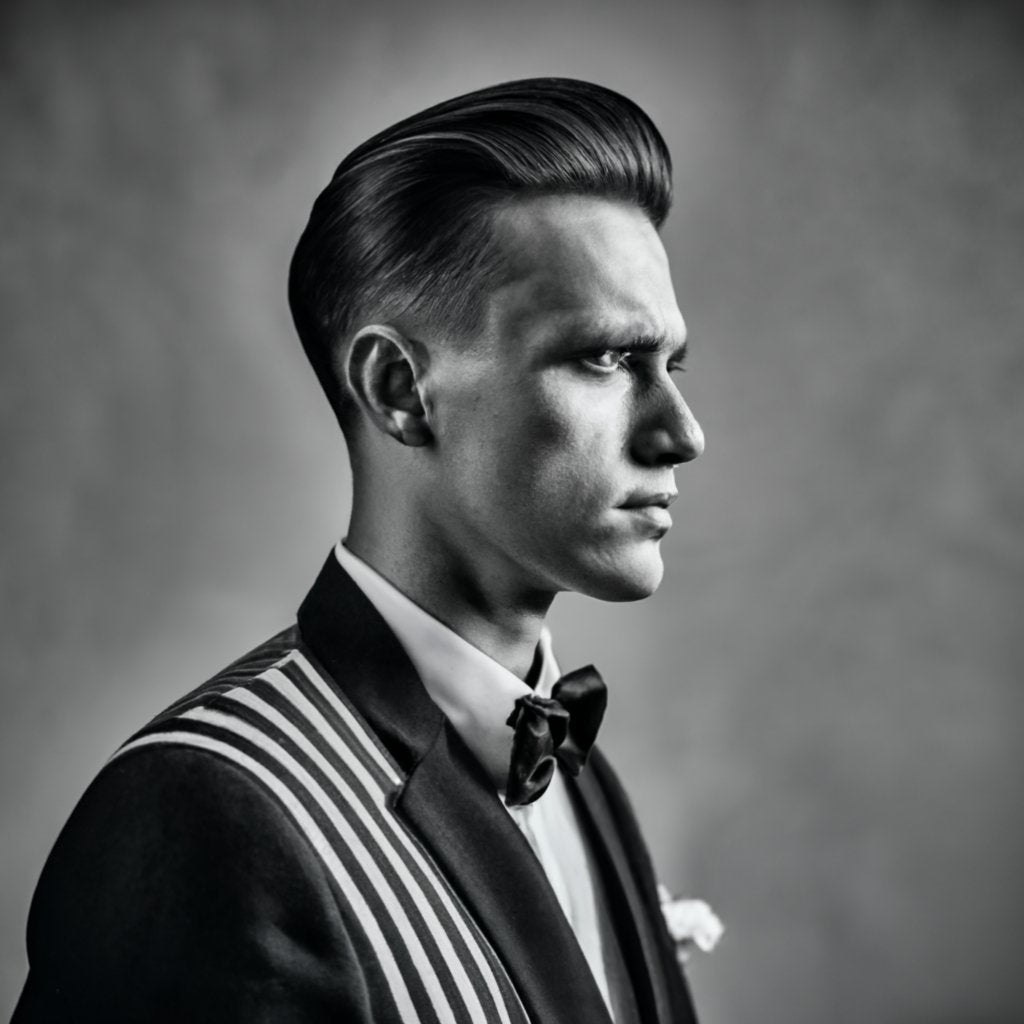
Indeed, the “Marcel Wave” and “finger wave” became iconic hallmarks of the era, offering a controlled elegance to the wearer's visage.
Hollywood's Impact
The influence of Hollywood's silver screen on 1920s men's hairstyles cannot be understated, shaping public taste and setting the bar for sophistication and elegance.
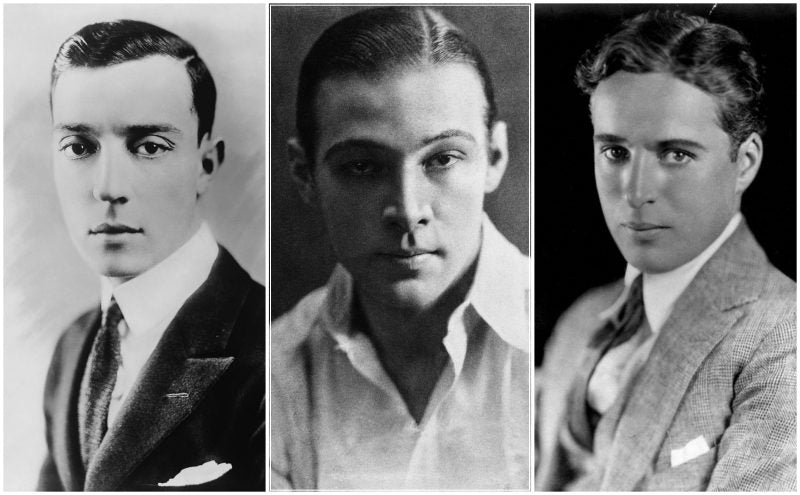
Celebrities were the trendsetters, with stars such as Rudolph Valentino epitomizing the slicked-back hair look that became the hallmark of the era. Movie icons were the ambassadors of style, their dapper appearances on film often translated into everyday fashion by eager audiences. They popularized sharply parted hair embellished with a high-shine finish, a look that became de rigueur for men striving to emulate their on-screen heroes.
Moreover, Hollywood's cinematic tales often showcased leading men with impeccably managed locks, regardless of their script's backdrop. This consistent portrayal of well-groomed hair on screen meticulously underscored the importance of a put-together appearance, subtly influencing men to prioritize their own grooming rituals. The character-driven hairstyles presented on the silver screen were not just aesthetic choices; they were narrative devices enhancing characters' personas, reflecting their status, and contributing to the movie's overall appeal and credibility.
Consequently, silver screen idols fostered a surge in male grooming product consumption. The use of gels, pomades, and tonics increased exponentially as men sought to replicate the hairstyles of their celluloid counterparts. This emulation went beyond personal aesthetics; it was a bid for the poise, prestige, and allure that Hollywood's leading men projected. The film industry didn’t just entertain; it innovated style, propelling the popularity of certain hair trends and solidifying their place in the annals of hairdressing history.
Tools for Styling Waves
Precision was paramount for the 1920s gentleman.
To create the deep, controlled waves characteristic of the decade, men relied heavily on a variety of grooming tools. These were not mere accouterments of vanity but instruments of personal branding and social status. The most essential items in a man's styling arsenal were steel combs, wave clamps, and hard-toothed brushes, which together facilitated the sculpting of sleek, undulating coiffures. Importantly, these tools reflected the technological advancements of the era, which began to bring salon-level precision into the home.
Wave-setting required both skill and the right instruments.
The method of styling involved applying heavyweight products—often petrolatum-based pomades. Preceding the application, warming the product was crucial - a technique that made it more malleable and easier to distribute evenly through the hair, using the aforementioned tools to set the desired waves.
One must not discount the role of dryers in this process.
The practice of hair drying had evolved: contemporary styling necessitated using hand-operated or bonnet dryers, rudimentary by today's standards but innovative for their time. These machines helped to set and fix the waves after thorough combing and brushing had brought them into form.
Learned techniques and advanced tools shaped the iconic waves of the era.
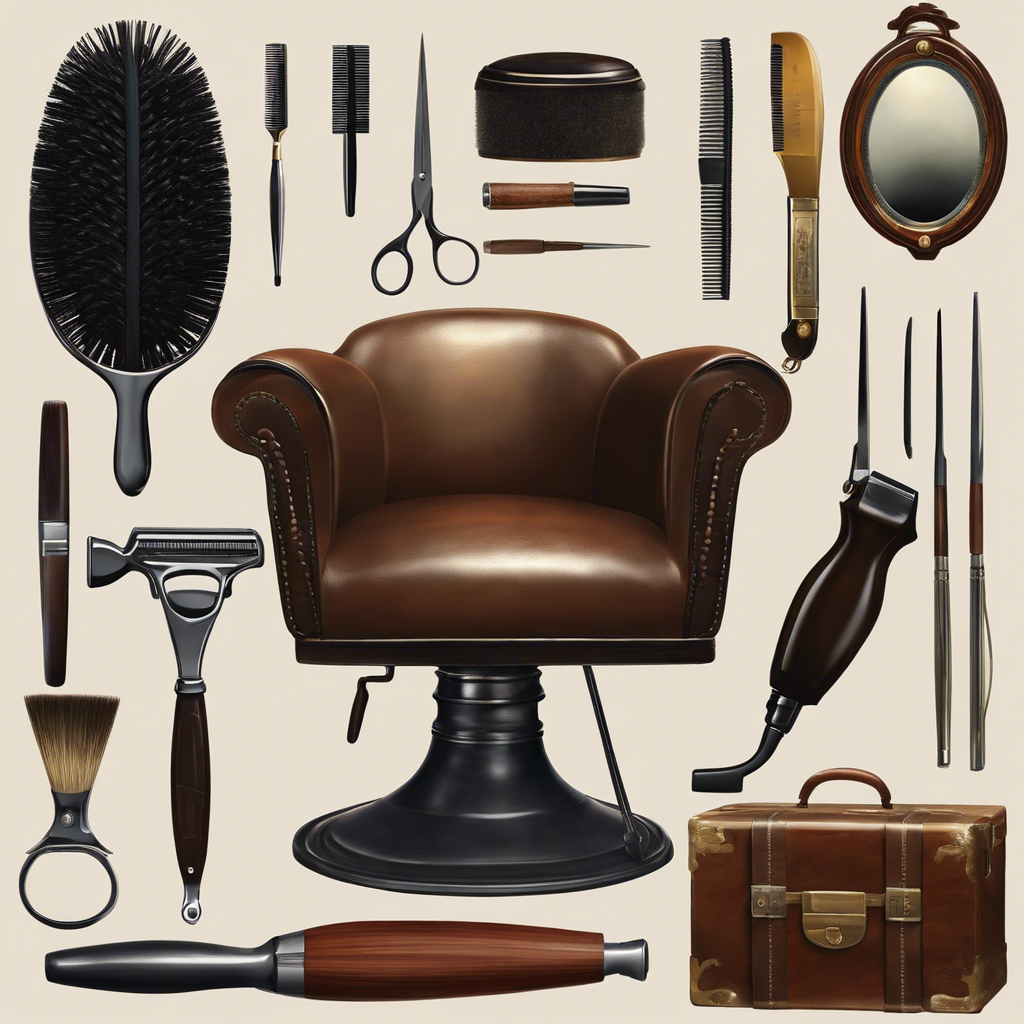
Following the initial styling, a silk or satin scarf would often be tied around the head overnight, ensuring that the waves set in perfectly for a polished look come morning. Without these fastidious practices and dedicated tools, the quintessential 1920s men’s hairstyles would not have achieved their legendary status in the sartorial annals of the early twentieth century.
The Crew Cut Emergence
The inclination toward streamlined and efficient styling gave rise to the crew cut, which quickly gained traction in the 1920s society. This no-fuss hairstyle represented a departure from the more elaborate coiffures of previous decades, embodying a modern and masculine ethos that resonated with the post-war generation.
It became a preferred choice among young university men, known colloquially as "crew" members. The functional aspect of the crew cut, in addition to its aesthetic appeal, fostered its growing popularity among these collegiate circles. Here, it was not just a haircut, but a symbol of camaraderie and unity within the rowing teams — hence the term "crew" cut.

Adopted beyond the academic realm, the crew cut personified the burgeoning desire for clean-cut sophistication. It reflected the societal impetus towards order and simplicity that characterized the Roaring Twenties. Uniform short length at the back and sides, with a slightly longer top, eased the daily grooming ritual while presenting a polished façade.
As the style permeated mainstream culture, its iterations expanded, remaining fundamentally rooted in the same principles of less-is-more. Hollywood quickly appropriated the crew cut, introducing it as a staple on the silver screen. Prominent figures sported this cut, firmly entrenching it as a hallmark of 1920s men’s fashion. In many respects, it became the archetype for what we now regard as a "classic" men's hairstyle.
What products were used to achieve 1920s men's hairstyles?
To achieve the iconic 1920s men's hairstyles, a combination of specific products were used to create the desired look. These products played a crucial role in achieving the sleek and sophisticated aesthetic that defined the era. Let's explore the key products that were commonly used:
- Brilliantine: This versatile hair product was a staple for men in the 1920s. Its lightweight and non-greasy formula helped to add shine and control to the hair without weighing it down. Brilliantine was often applied to damp or dry hair to create a polished and slick appearance.
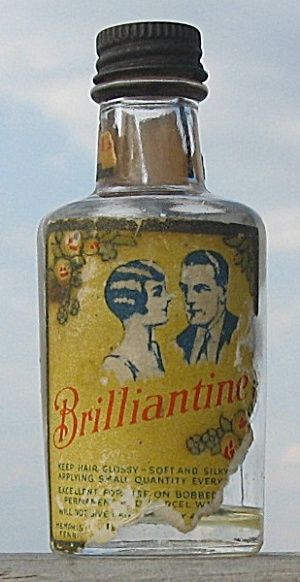
- Pomade: Another popular choice for styling 1920s men's hair was pomade. This product provided a strong hold and added texture to the hair, allowing for the creation of intricate styles such as finger waves or slicked-back looks. Pomade was typically applied to damp hair and combed through to set the desired shape.

- Hair Tonic: Hair tonics were commonly used as a grooming aid in the 1920s. These products were designed to invigorate and nourish the hair and scalp while promoting healthy growth. Hair tonics, often infused with botanical extracts, were used to add luster and vitality to the hair.
- Hair Wax: For men who sought a more structured and defined hairstyle, hair wax was a go-to product. Hair wax provided a firmer hold compared to other products, allowing for the creation of well-defined parts and sleek styles. It was typically applied to dry hair and evenly distributed using a comb or fingers.
- Combs and Hairbrushes: Alongside specific hair products, combs and hairbrushes were essential tools for styling 1920s men's hair. Fine-toothed combs were used to create precise parts and smooth out any flyaways, while hairbrushes helped to distribute product evenly and maintain the desired shape.
These products, combined with skilled hairstyling techniques, were the key to achieving the distinguished and refined hairstyles of the 1920s. By using a combination of brilliantine, pomade, hair tonic, hair wax, and the right tools, men were able to embody the elegance and sophistication that defined the era's hair trends.
What were popular hairstyles for men in the 1920s?
During the 1920s, men's hairstyles went through a significant transformation influenced by the cultural shifts and fashion trends of the time. The 1920s marked the advent of the “Roaring Twenties” and the rise of a new generation that embraced modernity, freedom, and self-expression.
One of the most iconic men's hairstyles of the 1920s was the slicked-back style. This suave and sophisticated look was achieved by applying pomade or hair oil to the hair and combing it straight back, creating a sleek and polished appearance. The slicked-back style was particularly popular among the well-dressed gentlemen of the era.
Another popular hairstyle that gained traction in the 1920s was the undercut. The undercut featured shorter sides and back, while leaving the hair on top longer and more voluminous. This style added both a touch of rebelliousness and elegance to men's look.
For those who preferred a more casual and carefree vibe, the shaggy or messy look became increasingly popular. This style featured longer and tousled hair, often accompanied by a center part or side-swept bangs. Men who embraced this hairstyle projected a more relaxed and effortlessly cool image.
Additionally, the curly or wavy hair was also highly sought after during the 1920s. Men with naturally curly or wavy hair often embraced their natural texture and allowed their hair to flow freely, creating an effortlessly stylish and dynamic look.
To add a touch of character and individuality, many men in the 1920s also adorned their hairstyles with accessories such as bowler hats, fedoras, or caps. These accessories not only added a fashionable flair but also complemented and enhanced their chosen hairstyle.
In summary, the popular hairstyles for men in the 1920s included the slicked-back style, undercut, shaggy or messy look, curly or wavy hair, and the addition of accessories. These hairstyles reflected the spirit of the time and the desire to experiment with new expressions of style and self.
What were some unique features or characteristics of 1920s men's hairstyles?
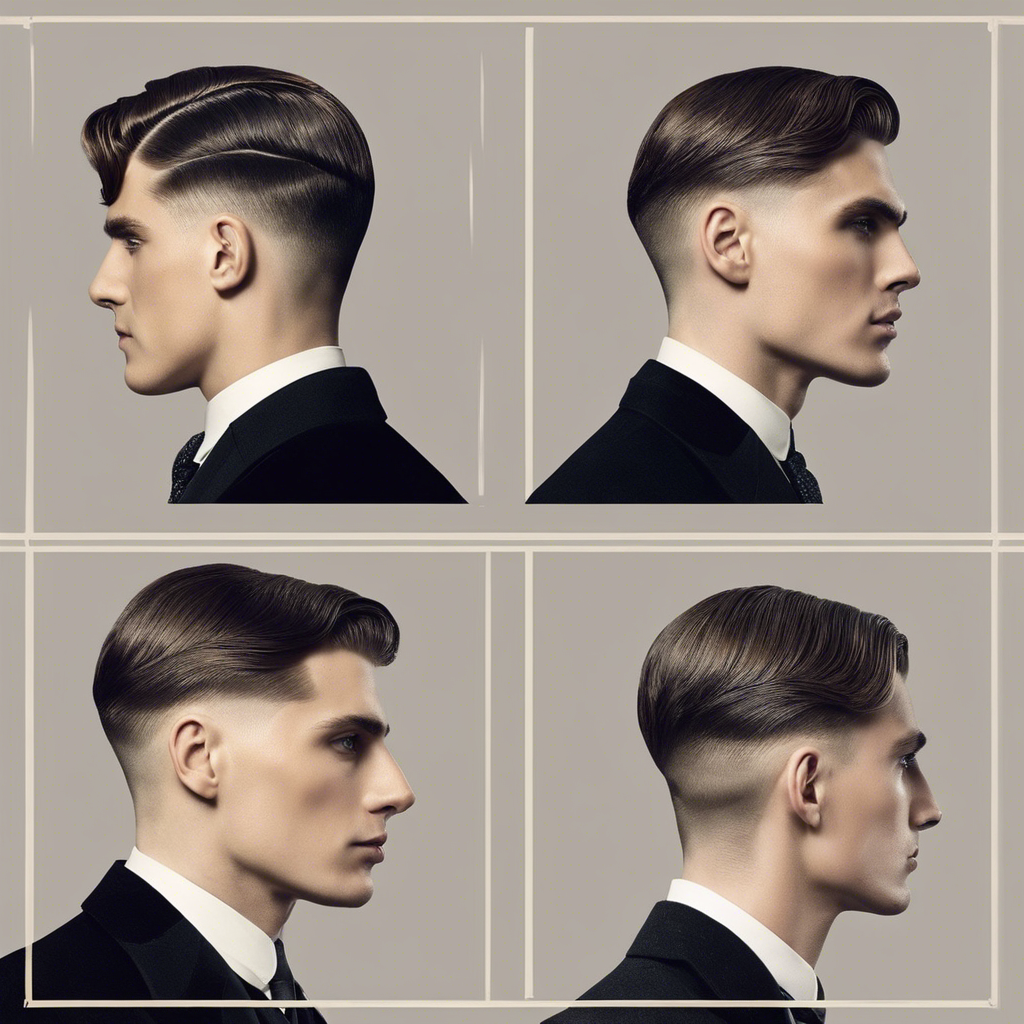
During the 1920s, men's hairstyles underwent a significant transformation, reflecting the changing social norms and cultural values of the time. One of the most distinctive features of men's hairstyles in the 1920s was the adoption of shorter lengths and sleek, slicked-back styles.
The popular hairstyle of the 1920s for men was the “slicked-back” look, where the hair was combed back and held in place with various styling products. This sleek and dapper style was embraced by men of all backgrounds, from the youthful rebels of the time known as the “flappers” to the conservative businessmen.
To achieve the slicked-back look, men would often use pomade or hair oil to add shine and hold to their hair. These products also helped to create a smooth, polished finish. Combs with fine teeth were used to meticulously comb the hair back, ensuring a precise and controlled appearance.
Another unique feature of 1920s men's hairstyles was the prevalence of side parts. A deep, defined side parting was a popular choice among men during this era. The part was often accentuated by sharply lining up the hair with a straight-edge razor, creating a distinct contrast between the two sides.
The use of hair accessories also played a role in defining men's hairstyles in the 1920s. One notable accessory was the colorful silk pocket square, which was often tucked into the breast pocket of suits, adding a vibrant pop of color and serving as a stylish embellishment.
Furthermore, the 1920s saw the rise of the iconic “undercut” hairstyle, characterized by short sides and a longer top. This style allowed for versatility as the longer hair on top could be styled in different ways, from slicked-back to wavy or even a pompadour.
Overall, the 1920s brought forth distinctive features in men's hairstyles that represented the spirit of the era. The sleek and refined looks, precise partings, and attention to detail showcased the elegance and sophistication that defined men's fashion during this iconic decade.

